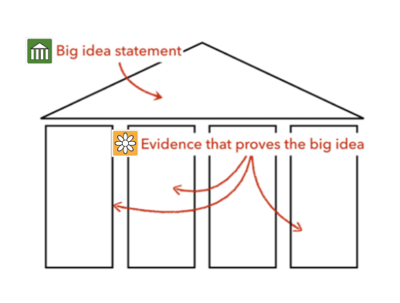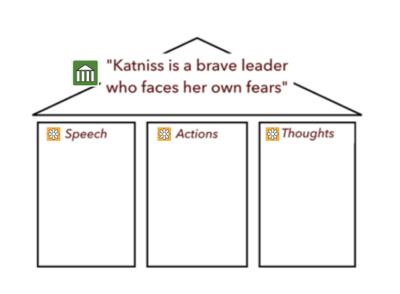I start my introduction of Depth and Complexity by partnering Big Idea and Details. They work nicely together.
- Big Idea zooms out. Students think about large, abstract statements.
- Details zooms in. Students focus closely on important specifics.
If you’re using emoji to represent the depth and complexity icons these are obvious choices: 🏛️ for Big Idea and 🌻 for Details.
🏛️ Big Idea
When students think about the Big Idea of a topic, we’re looking for a statement that sums up the content.
If we ask students to sum up a bike or a hamburger in one sentence, what would they say? It can be surprisingly difficult. After all, what exactly is a bike or a hamburger?
Big Idea might also prompt students to think about the purpose of a topic. What’s the Big Idea of a school or a family? A Big Idea might be a motto or a saying.
Looking At Content
You could ask students to identify the 🏛️ Big Idea of:
- A document like the US Constitution
- A concept like the periodic table of elements or plate tectonics
- A story, poem, or play
- A math topic like division
- A character or historical figure
Students’ answers will vary depending on their own sophistication. One student might see the Big Idea of the Constitution as “the rules of the United States,” but another might say that it’s “a tool to protect citizens from their leaders.” Both can be correct if justified with evidence (and the evidence is represented by the 🌻 Details prompt).
When applied to a person, the 🏛️ Big Idea might sum up their life’s accomplishments, their personality, or their purpose. What’s the Big Idea of Martin Luther King? How about Luke Skywalker? Cleopatra? How are all of these Big Ideas similar? (Note: I want to move up from mere “identify” questions, so I followed up with a “compare” question).
The Big Idea of Where the Red Fern Grows could be as simple as a summary of the plot, but it could also be the story’s theme or moral, or the author’s purpose.
Big Ideas can get even more abstract. We can take them beyond one topic. For example, the Big Idea 🏛️ “Growing up requires sacrifice” could be found in many stories, films, and historical contexts. We can use the Big Idea to connect within and across disciplines.
While students should definitely be coming up with their own Big Ideas, you should also offer your own for them to consider. Your Big Ideas will challenge their thinking and force new connections.
Oh, and it’s always possible to disagree with someone’s Big Idea. Obvious Big Ideas are no fun.
Beware trivial Big Ideas!
The whole purpose of depth and complexity is to push your most advanced students’ understanding of the topic.
Imagine our content is “George Washington”:
- 🚫 “George Washington” doesn’t cut the mustard. It’s merely a topic, not a Big Idea.
- 🚫 “George Washington was the first US president” is trivial. Let’s push your students beyond the obvious.
- ✅ “George Washington was a president who faced difficult decisions” is getting there. For young students, I’d say it’s a solid idea.
- ✅ “George Washington demonstrated that great deeds require sacrifice” is even cooler.
Note that both of the ✅ quality Big Ideas require evidence. I’m dying to hear students’ reasons! And that evidence will come in the form of our next prompt: 🌻 Details.
So, in summary, do not allow your students to turn in trivial or obvious Big Ideas! Advanced students should be given you advanced ideas.
🌻 Details
If the Big Idea is all about the main point, Details prompts students to look for the most important pieces of a topic.
Details isn’t about every single detail, of course, only the most important. You could begin your introduction by discussing the difference between Essential and Inessential Details.
- ✅ Essential Detail: the time period in which George Washington lived
- 🚫 Inessential Detail: the day of the week he was born on
Essential Details provide a great way to prove that a Big Idea is true. If students think the Big Idea of Where The Red Fern Grows is that “losses help us to grow up”, they’d need to find enough evidence (or Essential Details) from the story to prove this true.
If we say “George Washington was a president who faced difficult decisions,” obviously we need some Details to prove that Big Idea true.
Big Idea Graphic Organizer

The 🏛️ Big Idea’s icon looks like a Greek temple and is itself a useful graphic organizer (yes, Depth and Complexity pairs beautifully with graphic organizers). This shape shows the relationship between Details and Big Ideas. The roof holds the Big Idea and the structure below holds Details that support the Big Idea.

This emhpasizes that a Big Idea requires a certain amount of evidence to hold it up. Only one column is going to make a pretty weak structure. Three, four, or five columns are a minimum to hold up that roof.

For a slightly more advanced way of thinking, each column could represent a category of Details from a particular story, a unit, a person, etc. This is a simple way to get students thinking across multiple content areas.

I once based my whole science curriculum around the statement 🏛️ “Invisible power can have visible effects.” It was awesome!
However, don’t let this graphic organizer be the final product. Your students’ thinking should lead to a written response, a presentation, a skit, or some other complete work.
🏛️ Big Idea and 🌻 Details Tasks
Here are three introductory ideas for incorporating Big Ideas and Details into a task:
- Ask students to identify an interesting Big Idea and then support it with at least four essential Details.
- Offer students several possible Big Ideas about a topic and ask each child to choose one Big Idea to support with Details.
- Or, connect beyond one topic, asking students to create a Big Idea that applies to several stories, people, events, or other topics. In this case, each column of the organizer would hold evidence from a different topic.
In each case, students can use the Big Idea Graphic Organizer to organize their thinking, although the organizer certainly doesn’t need to be the final product.


